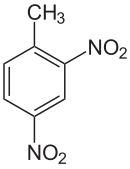 | |
 | |
| Names | |
|---|---|
| Preferred IUPAC name 1-Methyl-2,4-dinitrobenzene | |
| Other names Dinitrotoluol, Methyldinitrobenzene | |
| Identifiers | |
3D model (JSmol) | |
| ChEBI | |
| ChEMBL | |
| ChemSpider | |
| ECHA InfoCard | 100.004.046 |
| KEGG | |
PubChem CID | |
| UNII | |
| UN number | Molten: 1600 Solid or liquid: 2038 |
CompTox Dashboard (EPA) | |
| |
| |
| Properties | |
| C7H6N2O4 | |
| Molar mass | 182.134 g/mol |
| Appearance | Pale yellow to orange crystalline solid |
| Density | 1.52 g/cm3 [1] |
| Melting point | 70 °C (158 °F; 343 K) [1] |
| Boiling point | Decomposes at 250–300 °C [1] |
| Vapor pressure | 1.47·10−4 mm Hg at 22 °C |
| Hazards | |
| Occupational safety and health (OHS/OSH): | |
Main hazards | carcinogen, combustible (though difficult to ignite) [3] |
| Flash point | 207 °C; 404 °F; 480 K |
| Lethal dose or concentration (LD, LC): | |
LD50 (median dose) | 1,954 mg/kg (oral, mouse) [4] |
LDLo (lowest published) | 27 mg/kg (cat, oral) [4] |
| NIOSH (US health exposure limits): | |
PEL (Permissible) | TWA 1.5 mg/m3 [skin] [3] |
REL (Recommended) | Ca TWA 1.5 mg/m3 [skin] [3] |
IDLH (Immediate danger) | Ca [50 mg/m3] [3] |
| Explosive data | |
| Shock sensitivity | Insensitive |
| Friction sensitivity | Very low |
Except where otherwise noted, data are given for materials in their standard state (at 25 °C [77 °F], 100 kPa). | |
2,4-Dinitrotoluene (DNT) or dinitro is an organic compound with the formula C7H6N2O4. This pale yellow crystalline solid is well known as a precursor to trinitrotoluene (TNT) but is mainly produced as a precursor to toluene diisocyanate.